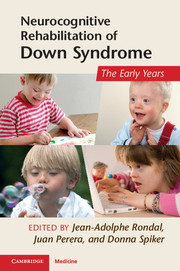Book contents
- Frontmatter
- Contents
- List of contributors
- Preface
- Acknowledgments
- Section 1 Definition, history, methodology, and assessment
- Section 2 Genetics, brain, and animal models
- 4 New perspectives on molecular and genic therapies in Down syndrome
- 5 Brain plasticity and environmental enrichment in Ts65Dn mice, an animal model for Down syndrome
- 6 Development of the brain and metabolism
- Section 3 Pharmacological and medical management and treatment
- Section 4 Early development and intervention
- Section 5 Therapeutic perspectives
- Conclusions
- Index
- References
4 - New perspectives on molecular and genic therapies in Down syndrome
Published online by Cambridge University Press: 05 July 2011
- Frontmatter
- Contents
- List of contributors
- Preface
- Acknowledgments
- Section 1 Definition, history, methodology, and assessment
- Section 2 Genetics, brain, and animal models
- 4 New perspectives on molecular and genic therapies in Down syndrome
- 5 Brain plasticity and environmental enrichment in Ts65Dn mice, an animal model for Down syndrome
- 6 Development of the brain and metabolism
- Section 3 Pharmacological and medical management and treatment
- Section 4 Early development and intervention
- Section 5 Therapeutic perspectives
- Conclusions
- Index
- References
Summary
Down syndrome and phenotypes
Trisomy 21 exerts a powerful downward effect on intelligence quotient (IQ). In contrast to normally developing children, there is a progressive IQ decline in Down syndrome (DS) beginning in the first year of life. The ratio of mental age to chronological age is not constant. By adulthood, IQ is usually in the moderately to severely retarded level (IQ 25–55) with an upper limit on mental age of approximately 7–8 years although a few individuals have IQ in the lower normal range (70–80). The molecular basis and the genes involved in this early decline across development are not known. This low IQ corresponds to an overall mental retardation. The short-term memory development of individuals with DS has been the subject of considerable research. Recent observation of the development of encoding strategies through the ages of 5 to 8 years suggests that this is a complex process involving the maturation of attentional and inhibitory processes (Palmer, 2000). The alterations in the cognition processes have not yet been related to the neuropathological features of DS.
At a gross morphological level, DS brains are smaller than normal. A 15%–20% decrease is generally reported (Jernigan et al., 1993; Pinter et al., 2001). Three brain areas are mainly altered: prefrontal cortex, hippocampus, and cerebellum. Postmortem studies and noninvasive brain imaging have revealed reduced sizes of the brain hemispheres, brainstem, and cerebellum (Kesslak et al., 1994; Raz et al., 1995).
- Type
- Chapter
- Information
- Neurocognitive Rehabilitation of Down SyndromeEarly Years, pp. 52 - 70Publisher: Cambridge University PressPrint publication year: 2011



